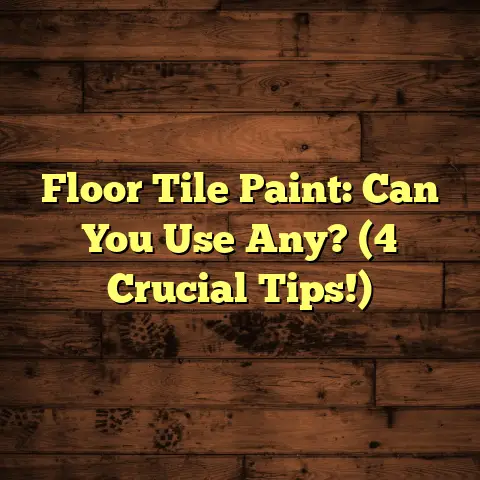Subfloor for Vinyl? (5 Critical Prep Steps!)
I’m excited to share my expertise on something crucial for a successful vinyl flooring project: subfloor preparation.
Trust me, as a flooring contractor with years of experience,
I’ve seen firsthand how a poorly prepared subfloor can lead to
nightmares.
We’re talking about uneven surfaces, premature wear,
and even complete flooring failure.
But don’t worry!
This guide will walk you through five essential
steps to ensure your vinyl flooring installation is not only
beautiful but also durable and long-lasting.
Step 1: Assessing Your Existing Subfloor
Okay, before we even think about laying down that gorgeous vinyl,
we need to play detective and assess the current state of your
subfloor.
Think of it as a health check-up for your floor’s
foundation.
Inspecting for Damage
First, grab a flashlight and get down on your hands and knees.
We’re looking for any signs of trouble:
- Rot: Discolored, spongy areas, especially near walls or
plumbing. - Mold: Musty smells and visible discoloration (black, green,
or white patches). - Water Damage: Stains, warping, or bubbling.
These issues can seriously compromise the integrity of your new
flooring.
If you find any of these, you’ll need to address them
before moving forward.
Ignoring them is like building a house on
sand – it’s just not going to hold up.
Checking for Level and Flatness
Next up: levelness and flatness.
I can’t stress enough how
important this is.
Vinyl flooring needs a smooth, even surface to
adhere properly.
Any significant variations will telegraph through
the vinyl, creating an uneven and unsightly finish.
So, how do we check?
Grab a good quality level (at least 6 feet
long is ideal) and a straight edge.
Place the level on the
subfloor and look for any gaps between the straight edge and the
surface.
As a general rule, variations greater than 1/8 inch over a 10-foot
span need to be addressed.
I often use a self-leveling compound
for larger imperfections, but we’ll get to that later.
Identifying the Material
Finally, figure out what your subfloor is made of.
Is it plywood,
concrete, or something else?
This is important because different
materials require different prep methods.
- Plywood: Common in many homes, but susceptible to moisture
damage. - Concrete: Durable but can be prone to moisture and unevenness.
- OSB (Oriented Strand Board): Similar to plywood but generally
less expensive and potentially more prone to swelling if exposed
to moisture.
Once you know what you’re dealing with, you can tailor your prep strategy accordingly.
Step 2: Cleaning the Subfloor
Alright, detective work is done!
Now it’s time to get down and
dirty (or rather, clean!).
A clean subfloor is absolutely essential
for proper adhesion of your vinyl flooring.
Removing Debris
First things first: sweep and vacuum the entire area thoroughly.
I mean, really go to town on it.
Any leftover dust, dirt, or
debris can create bumps or unevenness under your new flooring.
I personally use a shop vac with a brush attachment to get into
all the nooks and crannies.
Pay special attention to corners and
along walls.
Scrubbing Stains
Next up, tackle any stains, grease, or sticky substances.
These can
hinder adhesion and prevent your vinyl from bonding properly.
Use appropriate cleaners depending on the type of stain.
For
grease, I often use a degreasing cleaner.
For sticky residue,
mineral spirits can work wonders.
Always test the cleaner in an
inconspicuous area first to make sure it doesn’t damage the
subfloor.
Drying the Surface
This is a biggie.
Ensure the subfloor is completely dry before
moving on.
Moisture is the enemy!
It can lead to mold growth,
adhesive failure, and a whole host of other problems.
I usually let the subfloor air dry for at least 24 hours after
cleaning.
If you’re in a humid environment, you might need to use
a dehumidifier to speed up the process.
Step 3: Repairing Imperfections
Okay, the subfloor is clean as a whistle.
Now it’s time to play
handyman and fix any imperfections that could affect the final
result.
Filling Gaps and Cracks
Cracks and gaps are a no-go.
They can create weak spots in your
flooring and allow moisture to seep in.
Use a high-quality filler to patch up any cracks or gaps.
For
small cracks, a flexible crack filler works well.
For larger holes,
consider using a specialized patching compound.
I prefer
cement-based patching compounds for concrete subfloors and
wood-based fillers for plywood.
Make sure to follow the manufacturer’s instructions for application and drying time.
Sanding Rough Areas
Rough or uneven areas will telegraph through your vinyl flooring,
creating an unsightly finish.
Sanding these areas down will create
a smooth, even surface.
I use a hand sander with medium-grit sandpaper for most jobs.
For
larger areas, you might want to rent a floor sander.
Be careful not
to over-sand, as this can damage the subfloor.
Applying a Leveling Compound
If your subfloor is significantly uneven (remember that 1/8 inch
over 10 feet rule?), you’ll need to use a leveling compound.
This
is a self-flowing liquid that fills in low spots and creates a flat,
level surface.
I’ve used leveling compound on countless jobs, and it’s a lifesaver
for older homes with uneven floors.
Make sure to follow the
manufacturer’s instructions carefully.
You’ll typically need to
prime the subfloor first to ensure proper adhesion of the leveling
compound.
Pro Tip: When using leveling compound, create a dam around the
perimeter of the area you’re leveling.
This will prevent the
compound from flowing into other rooms.
Step 4: Moisture Testing
I can’t emphasize this enough: moisture is the bane of vinyl
flooring.
It can cause all sorts of problems, from mold growth to
adhesive failure.
Before you even think about laying down your vinyl, you must conduct a moisture test.
Using a Moisture Meter
A moisture meter is a handheld device that measures the moisture
content of the subfloor.
This is the most accurate way to determine
if your subfloor is dry enough for vinyl installation.
Vinyl flooring typically requires a moisture level below 5% for
concrete and between 12-15% for wood subfloors.
Check the
manufacturer’s recommendations for your specific vinyl product.
I use a pin-type moisture meter, which inserts small pins into the
subfloor to measure moisture content.
There are also pinless meters
available, which use electromagnetic waves to measure moisture.
Conducting a Plastic Sheet Test
If you don’t have a moisture meter, you can try the plastic sheet
test.
This is a less accurate method, but it can give you a general
idea of the moisture situation.
Tape a plastic sheet (about 2×2 feet) to the surface of the
subfloor and leave it for 24 hours.
If condensation forms underneath
the plastic, moisture is a concern that needs to be addressed.
Implementing a Vapor Barrier
If moisture levels are high, you’ll need to install a vapor barrier
before laying your vinyl flooring.
A vapor barrier is a thin layer
of plastic or other waterproof material that prevents moisture from
migrating up from the subfloor.
I typically use a 6-mil polyethylene vapor barrier for concrete
subfloors.
Make sure to overlap the seams by at least 6 inches and
tape them securely.
Did you know? According to the EPA, excess moisture can contribute to
the growth of mold and mildew indoors.
Source: EPA
Step 5: Final Preparations and Underlayment Installation
We’re almost there!
You’ve done the hard work of assessing,
cleaning, repairing, and moisture testing.
Now it’s time for the
final preparations.
Choosing the Right Underlayment
Underlayment is a thin layer of material that goes between the
subfloor and the vinyl flooring.
It provides a number of benefits,
including:
- Sound insulation: Reduces noise transmission between floors.
- Moisture protection: Provides an extra layer of protection
against moisture. - Cushioning: Makes the flooring more comfortable to walk on.
The type of underlayment you choose will depend on the type of vinyl
flooring you’re installing and the subfloor material.
Some vinyl
flooring products come with an attached underlayment, while others
require a separate underlayment.
I typically recommend a closed-cell foam underlayment for most vinyl
flooring installations.
This type of underlayment is waterproof,
durable, and provides good sound insulation.
Installing the Underlayment
Follow the manufacturer’s guidelines for underlayment installation.
Typically, you’ll need to roll out the underlayment and tape the
seams together.
Make sure the underlayment is laid out smoothly
without wrinkles or gaps.
Final Inspection
Before you start laying your vinyl flooring, conduct a final
inspection of the subfloor and underlayment.
Make sure everything
is properly aligned and ready to go.
Look for any remaining debris, uneven spots, or moisture issues.
Address any problems before proceeding with the vinyl installation.
Personal Story: I once worked on a project where the homeowner
skipped the moisture testing step.
A few months later, the vinyl
flooring started to bubble and peel up due to moisture damage.
They
had to rip up the entire floor and start over, costing them thousands
of dollars.
Don’t make the same mistake!
By following these five critical prep steps, you’ll set the stage
for a successful vinyl flooring installation that not only looks
great but also stands the test of time.
Your attention to detail in
preparing the subfloor will pay off in the form of a durable and
beautiful floor that enhances the functionality and aesthetics of
your space.
Remember, proper subfloor preparation is the foundation of a
successful vinyl flooring project.
Take the time to do it right, and
you’ll be rewarded with a beautiful and long-lasting floor.
Happy flooring!





